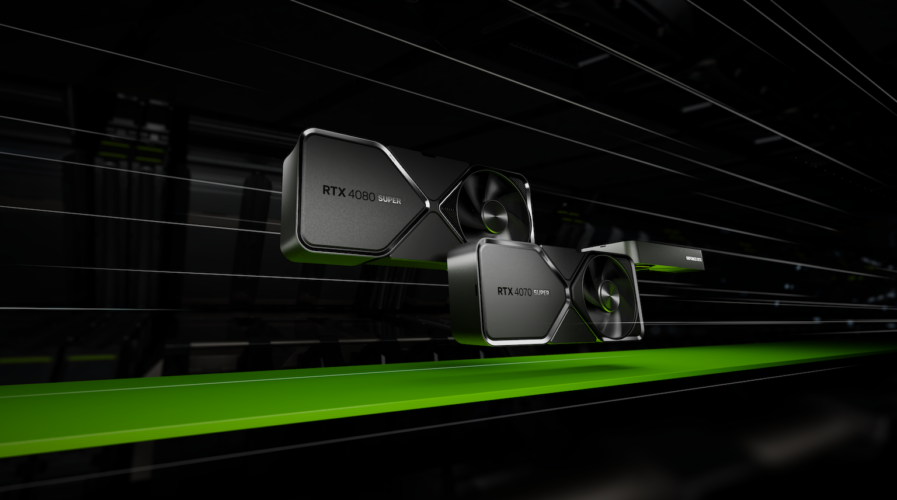
GeForce RTX 40 Super series. (Source – Nvidia).
Nvidia GeForce steps up gaming with RTX 40 Super series launch
- Nvidia unveils GeForce RTX 40 Super series GPUs, offering significant gaming and AI computing advancements.
- Nvidia’s RTX 40 Super series GPUs set new standards for performance and AI in PC gaming and creative tasks.
- Nvidia’s GeForce RTX 40 Super series and ACE microservices redefine AI-powered gaming and interactive experiences.
The gaming industry is experiencing a surge of revolutionary updates, and it’s only the second week of the new year. Amid this excitement, anticipation is growing for the predicted release of the Nintendo Switch 2. Adding to the buzz, Nvidia, a leading GPU provider, has recently unveiled a new addition to its GeForce RTX family.
Introducing the Nvidia GeForce RTX 40 Super series GPUs
Nvidia’s latest announcement introduces the GeForce RTX 40 Super series family of GPUs, including the GeForce RTX 4080 Super, GeForce RTX 4070 Ti Super, and GeForce RTX 4070 Super. These GPUs, which form the backbone of AI-powered PCs, supercharge the latest games and facilitate the creation of new entertainment worlds and experiences. The GeForce RTX 4070 Super, starting at US$599, is set to transform gaming and content creation with impressive capabilities.
The new Nvidia Ada Lovelace architecture-based GPUs deliver up to 52 shader TFLOPS, 121 RT TFLOPS, and 836 AI TOPS, significantly enhancing gaming and creative processes. With these GPUs, developing novel entertainment experiences becomes more accessible and powerful.
PC gamers who prioritize top-notch visual quality will find the AI-powered Nvidia Deep Learning Super Sampling (DLSS) Super Resolution, Frame Generation, and Ray Reconstruction, coupled with ray tracing, deliver stunning worlds in games like Diablo IV, Pax Dei, and Horizon Forbidden West. DLSS allows for AI generation of seven out of eight pixels, accelerating full ray tracing by up to four times while maintaining superior image quality.

GeForce RTX 40 Series laptops image – Slide image featuring new laptop announcements from major manufacturers including Acer, ASUS, DELL, HP, Lenovo, MSI, Razer and Samsung. (Source – Nvidia).
Matt Wuebbling, vice president of global GeForce marketing at Nvidia, notes, “For everyone from gaming enthusiasts to creative professionals, GeForce RTX Super GPUs are simply awesome upgrades. GeForce RTX Super cards support over 500 RTX games and applications and will have users prepared for the wave of generative AI apps coming to PC.”
The GeForce RTX Super GPUs mark a significant advancement in AI-powered PC computing. Specialized AI Tensor Cores deliver up to 836 AI TOPS, revolutionizing AI applications in gaming, creativity, and everyday productivity. The rich software ecosystem built on RTX GPUs further accelerates AI’s potential.
Nvidia TensorRT, a high-performance deep learning inference software suite, includes an inference optimizer and runtime that ensures low latency and high throughput. The open-source library TensorRT-LLM for Windows optimizes large language model inference performance. In AI tasks, the GeForce RTX 4080 Super generates video over 1.5 times faster and images over 1.7 times faster than the RTX 3080 Ti.
AI-powered DLSS enhances in-game immersion for gamers, while creative professionals, such as those using Adobe Photoshop, benefit from Tensor Cores for increased productivity. Nvidia Broadcast also improves productivity by removing background noise and offering seamless virtual backgrounds. GeForce RTX Super GPUs enable users to harness the full potential of AI on Windows PCs.
The GeForce RTX 4080 Super, available from January 31 starting at US$999, is basically a powerhouse for 4K gaming. It outperforms the GeForce RTX 3080 Ti by 1.4 times without DLSS Frame Generation and doubles its speed with this technology. With more cores and faster memory, it offers a significant performance edge.
The RTX 4070 Ti Super, ideal for high-frame-rate gaming at 1440p and up to 4K, surpasses the RTX 4070 Ti with more cores, a 16GB frame buffer, and a 256-bit memory bus. This boosts memory bandwidth to 672 GB/sec, making it 1.6 times faster than the RTX 3070 Ti and 2.5 times with DLSS 3. It will be available starting January 24 at US$799.
Launching on January 17 at US$599, the RTX 4070 Super offers a 20% increase in cores over the RTX 4070, outperforming the RTX 3090 with lower power consumption. With DLSS 3, its performance lead extends to 1.5 times faster.
Nvidia unveils ACE: a leap in interactive gaming
Nvidia also introduced production microservices for its Nvidia Avatar Cloud Engine (ACE), enabling game developers, tool creators, and middleware integrators to incorporate cutting-edge generative AI models into digital avatars in their games and applications.
ACE microservices allow developers to build interactive avatars using AI models such as Nvidia Audio2Face (A2F), which animates facial expressions from audio sources, and Nvidia Riva Automatic Speech Recognition (ASR), for customizable multilingual speech and translation applications.

Nvidia ACE microservices demo (Source – Nvidia).
Game development companies like Charisma.AI, Convai, Inworld, miHoYo, NetEase Games, Ourpalm, Tencent, Ubisoft, and UneeQ are already using ACE to enhance their gaming experiences.
Keita Iida, Nvidia’s vice president of developer relations, highlights the transformative impact of generative AI technologies in game creation and gameplay. With Nvidia ACE, developers can populate their worlds with lifelike digital characters, moving beyond pre-scripted dialogue and creating more immersive in-game interactions.
Transforming gaming characters with Nvidia ACE
Top game developers and interactive avatar creators are pioneering new ways to use ACE and generative AI technologies, transforming how players interact with non-playable characters (NPCs) in games and applications.
Tencent Games, a significant player in the gaming industry, acknowledges this as a pivotal moment for AI in games. They believe that Nvidia ACE, in collaboration with Tencent Games, will set a foundation for introducing digital avatars with unique, lifelike personalities and interactions into video games.
Nvidia ACE is bringing a new dimension to game characters. Traditionally, NPCs were designed with predetermined responses and animations, limiting player interactions to short, transactional exchanges often overlooked by players.
Purnendu Mukherjee, founder and CEO at Convai, points out the immense potential of generative AI-powered characters in virtual worlds. Convai uses Riva ASR and A2F to create NPCs with low-latency response times and high-fidelity, natural animations, enhancing the gaming experience.
Nvidia’s collaboration with Convai to expand the Nvidia Kairos demo showcases the transformative capabilities of ACE. In this enhanced version, Riva ASR and A2F are extensively used to improve NPC interactivity. Convai’s framework allows NPCs to engage in conversations, interact with objects, and guide players through game worlds, creating a more dynamic and interactive gaming environment.
This latest iteration of Kairos demonstrates how generative AI can revolutionize NPC interactions. NPCs can now converse among themselves, recognize and manipulate objects, and even guide players to objectives, offering a more immersive and interactive gaming experience.
The Nvidia GeForce RTX Super GPUs and ACE microservices are set to revolutionize gaming and PC computing. By harnessing the power of AI, Nvidia is creating a future where gaming and creative processes are more immersive, efficient, and engaging than ever before.
READ MORE
- Safer Automation: How Sophic and Firmus Succeeded in Malaysia with MDEC’s Support
- Privilege granted, not gained: Intelligent authorization for enhanced infrastructure productivity
- Low-Code produces the Proof-of-Possibilities
- New Wearables Enable Staff to Work Faster and Safer
- Experts weigh in on Oracle’s departure from adland


